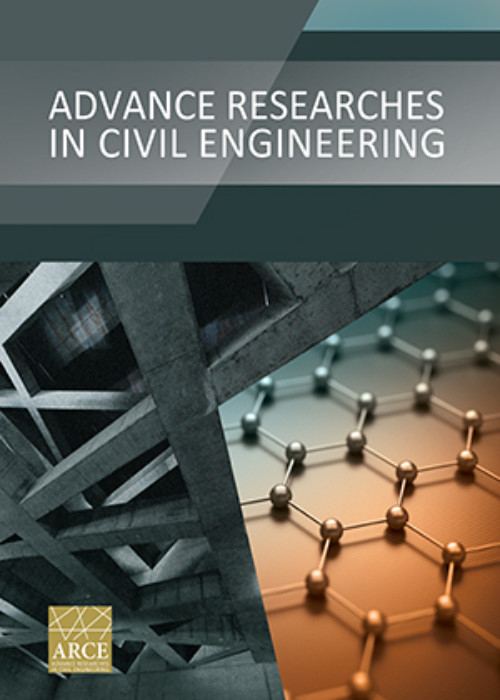فهرست مطالب
Advance Researches in Civil Engineering
Volume:3 Issue: 1, Winter 2021
- تاریخ انتشار: 1400/03/02
- تعداد عناوین: 5
-
Pages 1-13
In recent years, geopolymers, as a new class of green cement binders, have been considered as an environmental-friendly alternative to Ordinary Portland Cement (OPC) which can potentially reduce negative environmental impacts of OPC including: carbon footprint, energy consumption and etc. In this experimental research, effects of different alkaline activator solutions on the compressive, Tensile and flexural strengths, water absorption and resistance to acidic condition of fly-based Geopolymer Concrete (GPC) were investigated. Furthermore, a novel type of alkaline activator for GPC was introduced. In this regard, GPC specimens based on Class C fly ash were manufactured and cured in 90 ˚C. The obtained results showed that addition of NaOH to the mix after 3 min of mixing KOH and Na2SiO3 with dry components (1/3 of the total mixing duration) resulted in the highest compressive, tensile and flexural strengths as well as, the lowest water absorption capacity and weight loss under acidic condition, amongst other cases.
Keywords: Geopolymer concrete, Fly ash, Alkaline Activator, Compressive strength, Resistance to acidic condition -
Pages 14-33In this article the performance of structures with lateral bearing system of special reinforced concrete frame with special shear wall based on the third edition and draft of the fourth edition of the Iranian Earthquake Regulations has been studied. For this purpose, three structures of 10, 15 and 20 three-dimensional floors under linear dynamic dynamics analysis was performed, in which the 15-story structure is irregular. The structure is then analyzed with both of the above-mentioned regulations and then designed according to the ninth section of the National Building Regulations; Frame A of the three-dimensional structures is then subjected to push-up analysis. In the third version, taller structures, i.e. 15 and 20-storey structures, perform better than the fourth edition 2800, but this fact is the opposite for the shorter structure, i.e. 10-storeys, i.e. the 10-storey structure designed based on 2800 fourth edition has better performance than the same structure. But it is designed with the third edition. It should be noted that the structures are examined in the area away from the fault.Keywords: Special moment frames, Shear walls, especially, Shift, the earthquake, Structural performance
-
Pages 34-42Past earthquakes experiences identifies the need for buildings which are less vulnerable to damage and easier to repair after a major earthquake. In a major earthquake, traditional seismic lateral resisting systems can impose serious damages in structural system, leading to large residual drifts thus non-affordable to repair. Therefore, applying new types of structural systems which is known as low damage systems is promoted in framework of a resilience based design. These systems include components of rocking able frame, replaceable fuses and vertical post tensioning tendons to return the structure to its initial state. This paper, first, determines the effective parameters of the fuse, then their effect on seismic behavior of steel-braced frame are examined. According to the results, fuse can significantly influence the performance of the system and some trends to find its optimum characteristics are identified.Keywords: Lateral resisting system, rocking, Fuse, Post tensioning tendon
-
Pages 43-60
In construction projects in the world, there is generally a final cost overrun on the completion of construction projects. The cost overruns occur when the project has to face various risks due to the lack of anticipated preparation to minimize the risks that cause delays in the implementation of the sequence of work sequences. This is certainly a big problem in preparing construction project budgets and critical challenge for both owners and contractors, so it should be managed to decrease or avoid bad things. The purpose of this literature review is to present risks that cause cost overrun for the past ten years. Factors cause cost overrun; Cost Estimate, Construction Items, Project Participants, Environment, and Finance. This research used a systematic literature review. Based on 50 journals review about risks leading to cost overrun, the most factor causes cost overrun is Project Participants (25, 60%) with case Poor Planning, 2nd rank is Construction Items (22.67%) with case Frequent Changes in Design, 3rd Rank is Cost Estimates (22,00%) with case Inaccurate Cost Estimation, 4th rank is Finance (16,93%) with case Inflationary Pressure and last risk factor is Environment (12,80%) with case Weather Condition.
Keywords: risk, Cost Overrun, construction project -
Pages 61-69The effects of Quaternary, Holocene, and historic seismotectonics are of greatest relevance to dam construction. These effects pose the greatest hazards where the magnitudes of earthquakes are large and their hypocenters are shallow. The seismic hazard is the most severe hazard to be considered in the design of large dam projects located in high seismic areas. The earthquake hazard is a multiple hazard, so a thorough investigation is needed for the estimation of the ground motion of the different design earthquakes. This paper gives an overview on the seismotectonic setting of Saydoon dam sites in the context of Izeh fault zone, and the relevant design aspects of the selected dam sites. The main concern of the seismotectonic study is related to the identification and assessment of movements in the dam foundation during strong earthquakes. The presence of active faults and the possibility of movements along discontinuities in the footprint of the dam during strong earthquakes may have severe consequences on the selection of the dam type and the dam site. The Izeh Fault Zone, in which the studied dam sites are located, is a north south-trending structure specified by very intense folding and thrusting as well as medium to high seismicity and has been active during the Mid-Cretaceous and remained active into the Tertiary. Along this transverse fault zone, some evidences of dextral shear deformation structures such as dextral bending of fold axes, strike slip duplexes, and en-echelon folds are developed.Keywords: Seismotectonics, Izeh Fault Zone, Saydoon dam sites, Khuzestan Province


